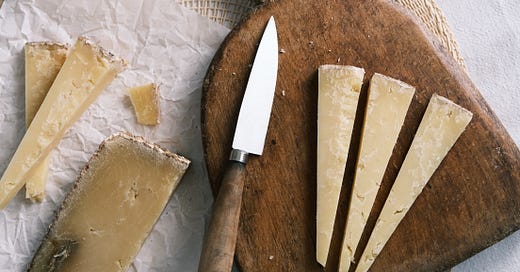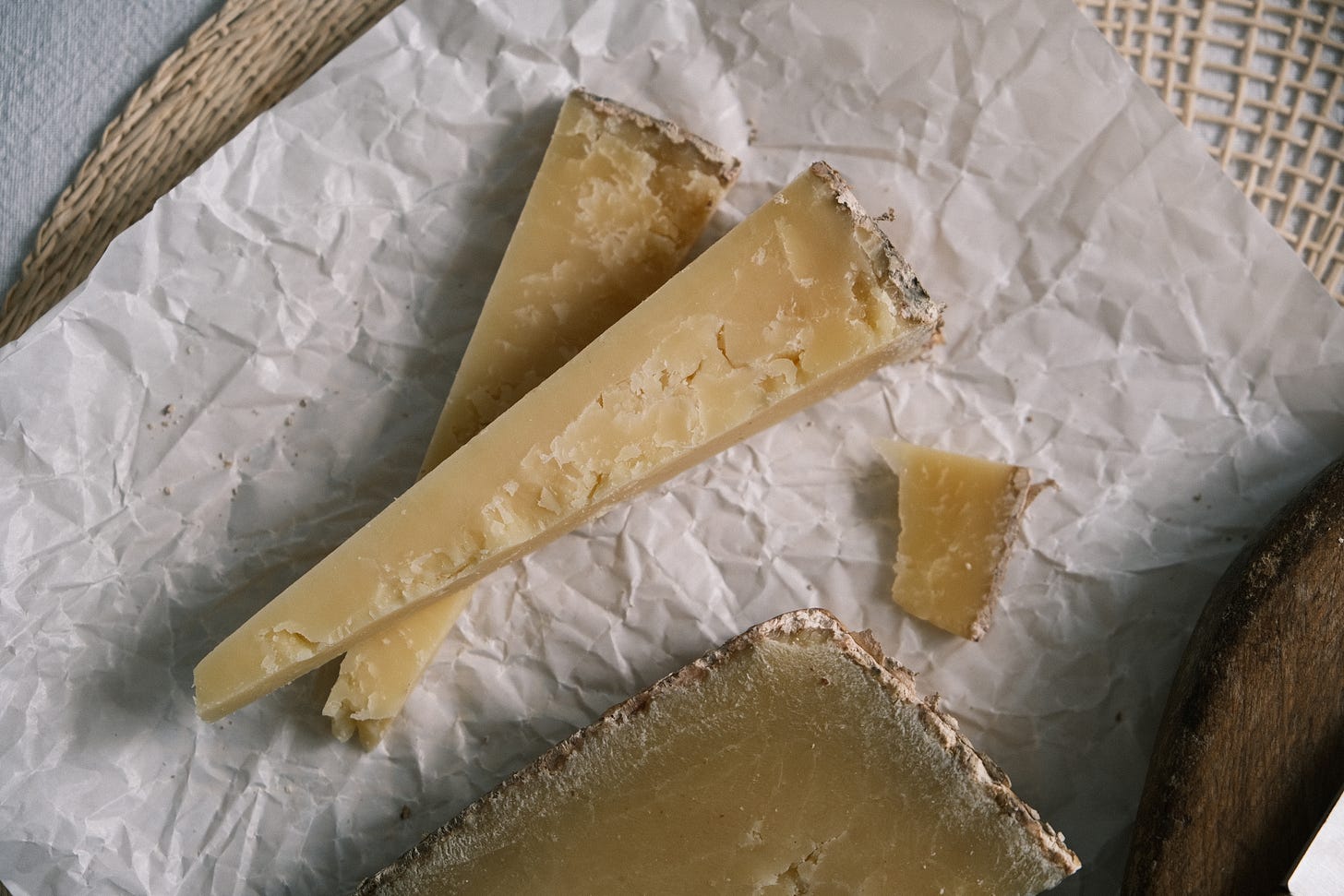At The Cheese Counter: Lincolnshire Poacher
The people behind it, its flavour profile and why you should try it.
‘At the Cheese Counter’ is a monthly instalment that discusses a particular cheese. From production methods to anecdotes and useful information. These are the cheeses you should ask for next time you visit your local cheesemonger and why you should try them.
—
I had my first taste of Lincolnshire Poacher in May 2020. I bought a chunk from Waitrose for a piece I was writing on how to put together the perfect cheeseboard. Little did I know it would become my favourite hard cheese and three years on it still is. It was love at first bite, my eyes widened as it first hit my tongue. Pure happiness ensued followed by instant regret, ‘how could I’ve only just heard of it?’.
A success from the very start
About ten miles from the east coast near Alford, on clover-rich pastures that sit on chalky land, lives a farm that has been tended by the same family since 1917. Ulceby Grange farm is situated at the top of the Lincolnshire Wolds, a designated Area of Outstanding Natural Beauty (AONB) and is the home of Lincolnshire Poacher.
It all started with Simon Jones, his father had been dairying on the farm since 1970, but it was Simon who came up with the idea of making cheese on a small scale after attending agricultural college.
In 1992, with the help of renowned Welsh cheesemaker Dougal Campbel (who learnt his cheese craft in the French mountains), the first batch of Lincolnshire Poacher is born. It proved to be a hit from the very beginning, so much so that “in the local cheese shop, customers were rationed to ¼ of a pound each.” 1 If this isn’t a sign of total success, I don’t know what is.
“Our grassland is clover-rich pastures, we don’t use any fertiliser and we think that gives a sweeter grass that transmits into sweeter, more complex cheese.”
- Simon Jones
Their gorgeous herd of 230 pedigree Holstein Friesian cows (milk from the same breed is used to make West Country Farmhouse Cheddar cheese), spend the summer out grazing in the pastures, from March to October approximately. They’ll then spend the winters on feed that is grown on the farm, a mixture of spring beans, winter wheat, as well as the farm’s own grass and maize silage.
What makes it a Lincolnshire Poacher?
First, a quick note on cheesemaking practices — when rennet is added to the milk to form a curd, the next steps will determine what kind of cheese you’ll end up with.
Once coagulated, cutting the curd block begins the process of releasing the whey (water) from the curds, therefore the size of the curds will determine how much whey is extracted. The bigger the curd size the less whey is extracted, perfect for making soft cheeses. If making crumbly or hard cheeses, the curds can be as small as the size of a pea or dried grain of rice. They are then cooked or scalded in the whey, the length and temperature that this is done at will also impact the type of cheese made.
For Lincolnshire Poacher, the curds are cooked for a bit longer than you would a traditional hard cheese, which results in drier, firmer curds (whether the temperature also varies from the standard, they don’t say). This, combined with a long maturation period (14-22 months), results in those sweet, fruity and nutty notes that make Lincolnshire Poacher so special.
What also makes artisan cheese as a whole so incredibly interesting is that the seasons have a lot to play in the flavour of the finished cheese. The effects the feed has on the cows’ milk are not to be overlooked. In this case, truckles made with spring and summer milk can taste sweeter, while those made with winter milk can taste savoury and nutty too.
Lincolnshire Poacher is not just an artisan cheese, it’s a picture of a place in time. Like good wine from a specific vintage and region, it can paint a picture of a particular season at the farm, and that’s something to be celebrated.
Flavour Profile
I think what makes Lincolnshire Poacher so likeable is the fact that it successfully merges two very well-loved varieties of hard cheese, farmhouse cheddar and Alpine cheese.
“West Country Cheddar meets Comté in this cheese, which typically boasts a smooth, densely creamy texture and flavours that can range from rich, savoury and brothy to long, sweet and almost pineapple-like.”
- Neal’s Yard Dairy
You get very clear savoury, mushroomy notes reminiscent of West Country Cheddar and a delectable sweetness and nuttiness, similar to Gruyère, Emmenthaler, and Comté.
I tend to prefer it when put against farmhouse cheddar because of its subtle flavours and reduced acidity. To me, farmhouse cheddar like Montgomery’s can be incredibly full-flavoured, and dare I say a bit too punchy. Don’t get me wrong I love a strong cheese, but I get to eat more of it when it’s as delicate as Poacher is.
Fact Sheet
Milk type and treatment - Raw cow’s milk
Coagulant - Animal Rennet
Location - Alford, Lincolnshire
Average age - LP 14-16 months / LP Vintage 18-22 months
Season - All year
Ingredients - Raw Cow's Milk, Salt, Cheese Cultures, Animal Rennet

Have I convinced you to give it a try? Or have you tried it before? I’d love to read your thoughts, leave me a comment below.
To finish, half a sonnet for the third love of my life.
O Lincolnshire Poacher, you make my heart sing. It’s not every day I get to eat you, you’re such a wonderful cheese. If I ever had to give you up, it’d be the saddest day of my life. I don’t know what I’d do without you, I rather not think about that.
About us - Lincolnshire Poacher - www.lincolnshirepoachercheese.com
Other sources:
“Lincolnshire Poacher Cheese quadruples sales in Europe” Lincolnshire Live - www.lincolnshirelive.co.uk
Lincolnshire Poacher - Neal’s Yard Dairy - www.nealsyarddairy.co.uk






